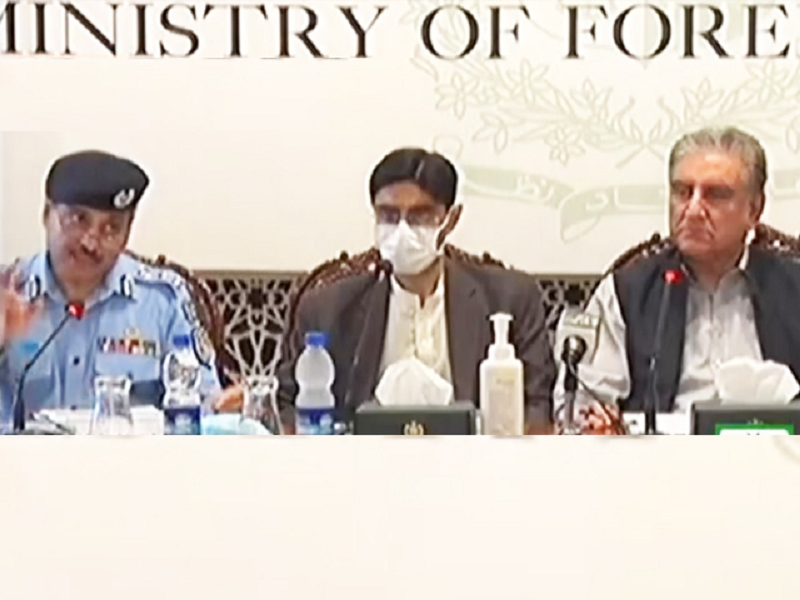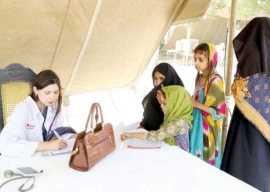
Somewhere between the claims of the daughter of Afghanistan Ambassador to Pakistan Najibullah Alikhil that she was assaulted in a taxi and the police saying that they found no evidence of her alleged kidnapping and assault lies the truth.
Addressing a news conference along with Foreign Minister Shah Mahmood Qureshi and National Security Adviser Moeed Yusuf on Monday, the capital’s police chief said that the evidence that the police gathered doesn’t corroborate with what the ambassador’s daughter, Selsela Alikhil, stated in her complaint.
“Our investigation is almost complete,” Inspector General of Police (IGP), Islamabad Qazi Jameelur Rehman said. “The impression that came in the meanwhile [abduction and assault] does not match our evidence.”
Answering a question, the police chief said, the police have ascertained many things but “we need their support, cooperation and facilitation to determine all these things”.
The top-ranked official said, “We have a lot of evidence and the need is to sit and discuss everything with them to make things clear. We are almost there. Very close. We now need their help and support so that we all can sit together and discuss this matter.”
Sharing details of the police investigation into the alleged abduction and release of the Afghan ambassador's daughter in Islamabad last week, the IGP narrated the whole incident that has been verified by technical as well as human resource teams in the last three days.
Declaring that the case is extremely important and sensitive, the IGP said, reporting and working out such an incident – “a totally blind case” – was a challenge for the police.
The capital’s top cop said that no details of the incident were available after the report was filed with the police. “The police did not even know if any taxi was used; who was the driver and where did they go.”
Rehman said that the Islamabad police utilised all of its resources – made five dedicated teams, including technical analysis team, human intelligence analysis, raids and operations team and data analysis team, which was thoroughly supported by the intelligence agencies.
In the investigation process in the last three days, he said, over 300 cameras were scrutinised, which included Safe City’s and private cameras installed at different locations in the twin cities. The IG said that over 700-hour-long video recordings were monitored and over 220 people have so far been interviewed, adding that it’s a common practice in the country that the vehicle is driven by someone else and not the owner and there were occasions where a vehicle had multiple owners.
He said that the teams worked round the clock – checked the owners, traced their locations, reached and investigated them only to find out that the owner had sold the vehicle to someone else. “We found a vehicle which had five owners,” he said, adding that the police reached to the last man based on the information obtained from the previous owners.
Also read: Security of Afghan embassy, consulate in Pakistan enhanced: FM Qureshi
Rehman said that over 350 police officials, including women, were working on the case round the clock for the past three days.
The police chief said that the sum up of all these efforts enabled the police to determine and verify the route that the complainant had taken right from leaving her residence to reaching back to it.
Narrating the incident with the help of the evidence collected, the IGP said the complainant left home on foot and took the first taxi in which she travelled from Rana Market to Khadda Market and bought a gift from there. He said the police traced the taxi owner and verified the details of her travel route.
Then, he said, the complainant took the second taxi from Khadda Market to Rawalpindi, saying: “It’s important because the complaint that we have received states that the incident took place in the second taxi, as she says, a man assaulted her after he entered the taxi five minutes into the drive.”
The police traced the second taxi, he said, adding that the vehicle was traced and had three owners whom the police reached after investigating one after the other.
The IG said that the driver verified that he took her from Khadda Market to Saddar, Rawalpindi and charged Rs600, adding that all the CCTV footages from Khadda Market to Expressway to Faizabad and Saddar, Rawalpindi have already been obtained.
Subsequently, the top cop said, the investigation teams reached the point where the taxi driver dropped her, adding that the same was verified by eight CCTV cameras installed at Saddar, Rawalpindi. The driver’s mobile phone was also tracked and it matched the route as well as the destination with accurate timing.
Then, she hired another taxi from Saddar, Rawalpindi to Damn-e-Koh in Islamabad, he maintained, adding that the police got a clue about her from the CCTV cameras installed around Damn-e-Koh. He said that they traced the taxi driver who confirmed that he took her from Saddar, Rawalpindi to Damn-e-Koh for Rs700.
Here, he said, the fourth taxi comes into play. The police chief said that the fourth taxi driver picked her from Damn-e-Koh and dropped her at F-9 Park, adding that on her instructions, the driver took her to F-6 before going to F-9 Park.
The IG said that the driver told the police that she asked him to take her to F-6 as she wanted to use a phone, saying that the complainant’s house is located at F-7 and the embassy at F-6. After she couldn’t find a phone, he said, she asked the taxi driver to drop her at F-9 Park, which he ultimately did.
At F-9, she used someone’s phone to make a call to the embassy and later the embassy staff came to pick her up and dropped her at her residence. He said that the person whose phone she used has also been identified.
Rehman said that the whole track – from home-to-home travelling – was identified as well as verified; all the drivers have been verified; their technical record as well as the safe city and private cameras also verify the same.
Rehman said that the police have sought further assistance from the Ministry of Foreign Affairs to address a few points in the case and sent a verbal note as well.
Talking to the media persons, NSA Yusuf said the false social media campaign orchestrated by verified Indian social media accounts, which shared a false picture of the Afghan envoy's daughter, was part of the hybrid warfare against Pakistan.
The Indian propaganda was aimed at creating rifts between Islamabad and Kabul, quoting the EU DisinfoLab report, which had exposed the Indian network of fake news outlets which were maligning Pakistan at the international fora.
Identical social media accounts, which spread propaganda related to Kashmir and Balochistan, had been found involved in fanning fake news regarding the purported abduction saga of Afghan ambassador's daughter, he added.
Some spoilers of peace, he said, were trying to make Pakistan a scapegoat of their failures and they were trying to establish a false narrative that Pakistan and Afghanistan were eternal enemies.
He also highlighted presentations showing various hoax social media campaigns generated through bots and verified Twitter accounts operating from India, Afghanistan and within Pakistan.
(With input from APP)



















COMMENTS (6)
Comments are moderated and generally will be posted if they are on-topic and not abusive.
For more information, please see our Comments FAQ